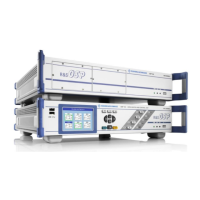Operating Manual 1505.3896.12 - 14 139
6.2.3.4 Responses to Queries
A query is defined for each setting command unless explicitly specified otherwise. It is
formed by adding a question mark to the associated setting command. The following
rules apply to the responses:
● The requested parameter is transmitted without header.
Example: CONFigure:RELay:DELay? (@F01A11(0104))
Response: 2 (corresponds to 100ms = 2*50ms)
● Character strings are returned enclosed in quotation marks.
Example: ROUTe:PATH:CATalog?
Response: ”path1”,”path2”
6.2.3.5 SCPI Parameters
Most commands require one or more parameters to specify their function. The
parameters must be separated from the header by a "white space". Permissible
parameters are numerical values and character strings. The parameter types and the
permissible ranges of values are specified in the command description.
Overview of Syntax Elements
The colon separates the key words of a command. In a command line the
separating semicolon marks the uppermost command level.
The semicolon separates two commands of a command line. It does not alter the
path.
The comma separates several parameters of a command.
The question mark forms a query.
The asterisk marks a common command.
Quotation marks introduce a string and terminate it.
A "white space" (ASCII-Code 0 to 9, 11 to 32 decimal, e.g. blank) separates header
and parameter.
6.2.3.6 Use of SCPI Subsystems
The structure of the instrument-control commands implemented by the R&S OSP is
described in chapter 7.4, Instrument-Control Commands. Due to this structure, some
SCPI subsystems are used in a specific manner. The following list gives an overview.
Controls relays and I/O channels
Fetches the condition of I/O input channels and operation counters

